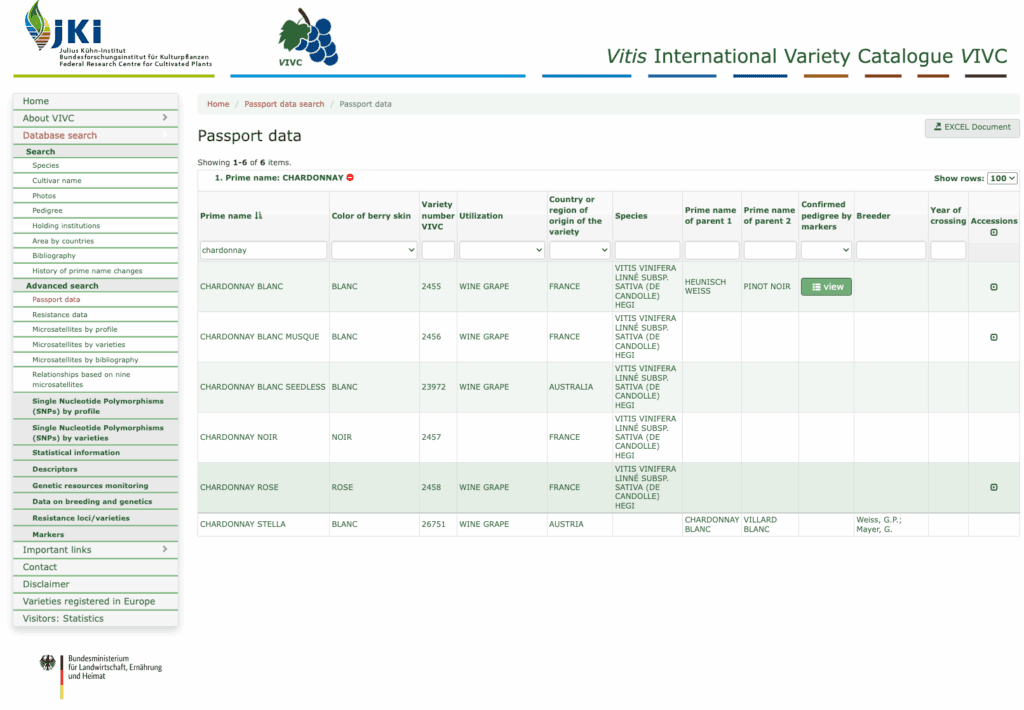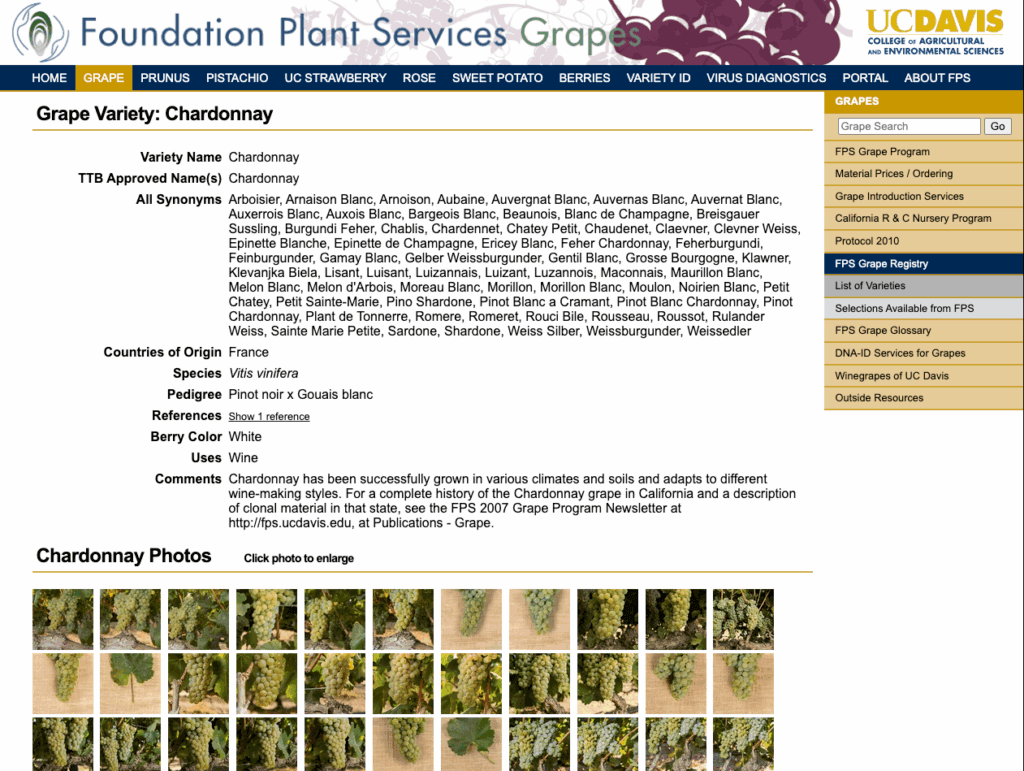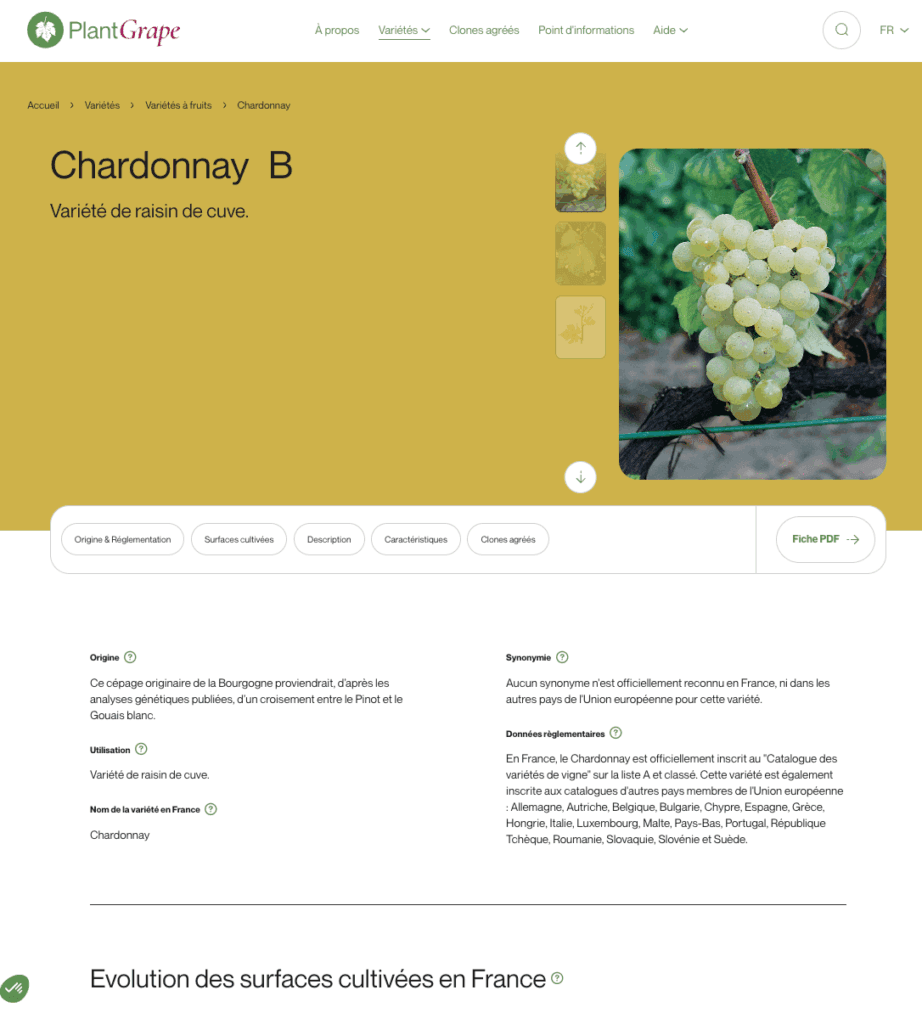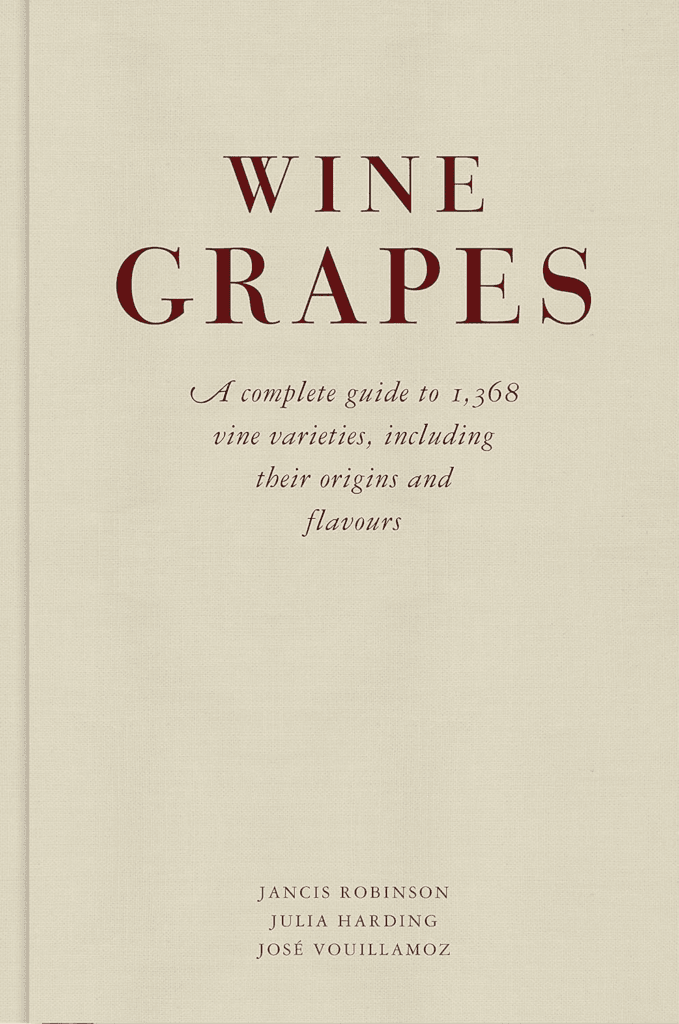
| Title | Wine Grapes, A complete guide to 1,368 vine varieties, including their origins and flavours |
| Author | Jancis Robinson, Julia Harding, José Vouillamoz |
| Publisher | HarperCollinsPublishers | Penguin Books Ltd. |
| Date | 2012 |
| ISBN | US Hardcover: 978-0062206367 UK Hardcover: 978-1846144462 [e-book] |
| Pages | 1280 |
| Shop | www.jancisrobinson.com |
About the Book
José had an idea for a book he wanted to discuss with us. He was proposing a book that looked in detail at the genetic and historical background to all the major international grape varieties, the likes of Cabernet Sauvignon, Syrah, Nebbiolo, Chardonnay and Riesling, for he had already amassed considerable original research material on all these.
I thought it would indeed be exciting to publish a more expert and up-to-date view on these varieties than I had managed to assemble in the mid 1980s for my Vines, Grapes & Wines, the first book about wine grapes to be aimed at consumers. But I thought we could do better than that.
There are, at the latest estimate, about 10,000 different vine varieties in total, so we decided to limit ourselves to those that produce wine commercially.
- The inside story of Wine Grapes, Jancis Robinson, JancisRobinson.com, 2012
- en.wikipedia.org/wiki/Wine_Grapes

About the Authors
Jancis Robinson is a highly respected British wine critic, journalist, and author. She writes a daily column for her website, JancisRobinson.com, and a weekly column for the Financial Times. In 1984, she became the first person outside of the wine trade to pass the Master of Wine examination. Robinson is the editor of The Oxford Companion to Wine and co-author of The World Atlas of Wine, both considered standard reference works. She was awarded an OBE by Queen Elizabeth II in 2003 and advises on the Royal wine cellar.
- Jancis Robinson – the long version, JancisRobinson.com
- en.wikipedia.org/wiki/Jancis_Robinson
- www.ft.com/jancis-robinson
- www.mastersofwine.org/jancis-robinson-mw
Julia Harding is a Master of Wine who writes for JancisRobinson.com. After a career in publishing, she retrained in wine and became a Master of Wine in 2004, winning the Robert Mondavi Winery Award for her performance in the theory exams. She is a co-author of Wine Grapes and has contributed to and edited other major wine publications, including The Oxford Companion to Wine and The World Atlas of Wine.
Dr. José Vouillamoz is a Swiss botanist and grape geneticist of international renown. He specializes in the origin and parentage of grape varieties through DNA profiling. Dr. Vouillamoz worked with Dr. Patrick McGovern at the University of Pennsylvania Museum and with Professor Carole Meredith, a leading grape geneticist at the University of California, Davis. His research has been crucial in establishing the family trees of grape varieties presented in Wine Grapes.
About the Illustrations
Wine Grapes includes full-page color reproductions of 80 of the 500 paintings produced for the 7-volume, 3,200 page book, Ampélographie, by Pierre Viala and Vitor Vermorel published between 1901 and 1910.
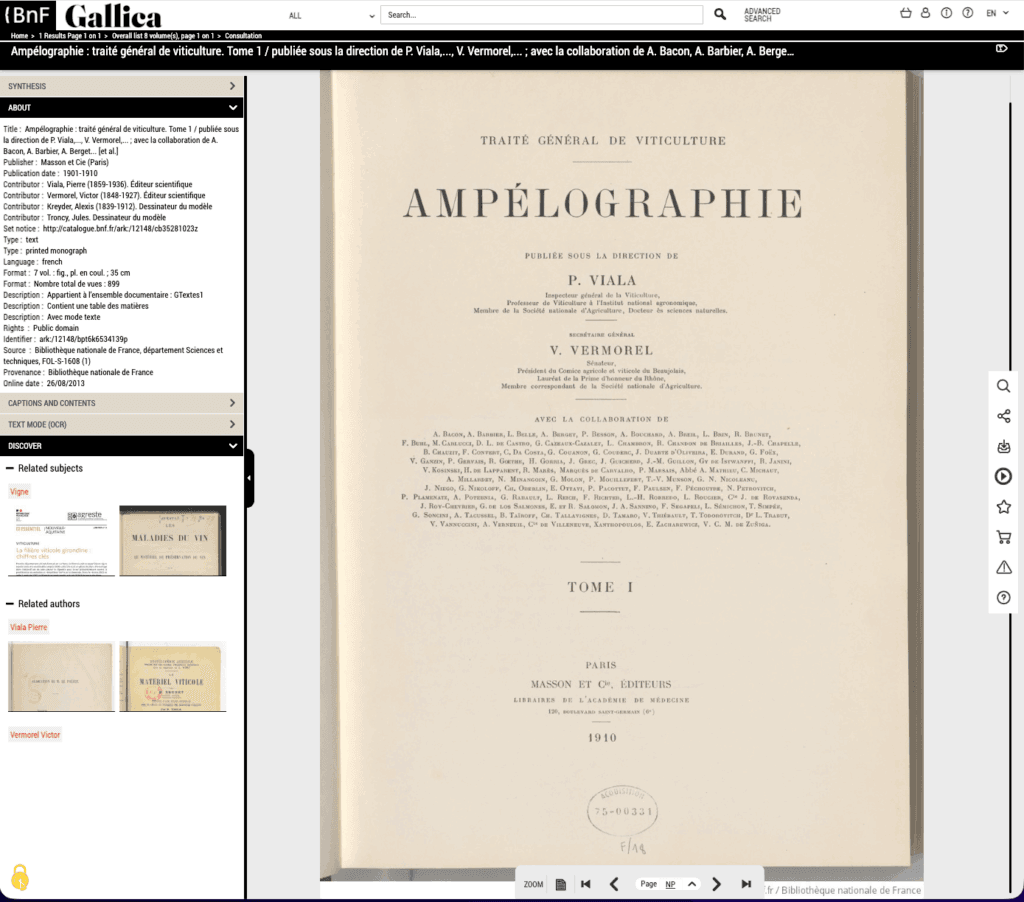
Book Reviews
- The great grapevine, Jancis Robinson, FT, 2012
- Journal of Wine Economics
In a review by Professor Kym Anderson, the book is described as an “extraordinary addition to the literature on varieties”. Anderson, an academic, praises the book for its immense scope, scientific rigor based on DNA analysis, and beautiful presentation. The review highlights the book’s timeliness in the context of globalization, climate change adaptation, and biotechnology. It is considered comprehensive for its focus on the book’s scientific and economic importance. - Wine & Viticulture Journal
Viticultural scientist Dr. Richard Smart calls the book a “seminal masterpiece” and one of the most significant books ever published on the subject. His review is comprehensive in its praise for the book’s structure and content from a scientific standpoint. He commends the detailed explanations of how grape varieties originate, the well-organized entries for each of the 1,368 varieties, and the inclusion of over 300 previously unpublished relationships between grapes. Smart predicts the book will become a standard reference in both popular and scientific literature. - Vinography, Alder Yarrow. 2012
- Wine & Spirits, Tara Q. Thomas, 2012
- Highlights From the 2012 Vintage in Wine Publishing, Eric Asimov, The New York Times
Awards
- Best Drinks Book 2012, Wine & Spirits magazine
- Hall of Fame for Best Wine Book, Gourmand World Cookbook Awards 2013
- Best Drink Book 2012, André Simon Awards
- Best Beverage Book 2013, James Beard Awards
- Food and Drink Awards, Drink Book 2012, Fortnum & Mason
- Louis Roederer Wine Writer Awards 2013
- Best Viticulture Book 2013, OIV Awards
Pedigrees
Wine pedigree maps are available for download from
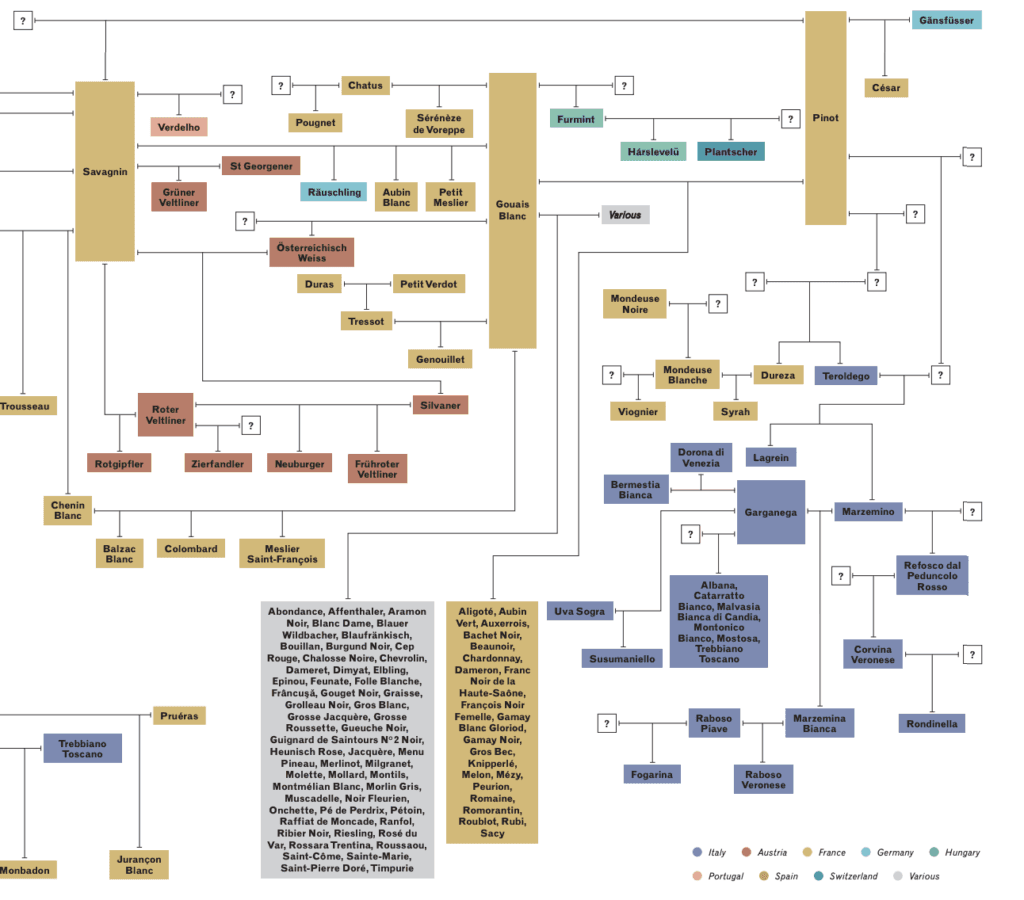
Introduction
- Importance of Grape Varieties
Until the mid-20th century, wine was mostly labeled by region, not grape; varietal labeling (Cabernet Sauvignon, Chardonnay) simplified wine identification outside Europe, especially from the 1980s onward. This sparked deeper interest in grape varieties among both consumers and producers. - Explosion of Variety Cultivation
While familiar varietals once dominated, today there is a revival of indigenous and local varieties worldwide—Italy alone cultivates around 380 distinct varieties. Efforts exist globally to save historic or lesser-known grapes from extinction. - International Exchange and Heritage
Modern nursery networks and international curiosity have led to global exchanges of vine cuttings, reviving old, local varieties even outside their native regions. - Varietal, Mutations, and Clones
- Each variety originates from a seed, the result of sexual reproduction.
- Mutations occur naturally within clones of a variety; notable examples include skin-color mutations (Pinot Noir, Gris, Blanc).
- Clones are vegetatively propagated versions of a variety selected for useful traits (yield, ripening, disease resistance).
- Vine Breeding
Many varieties are bred deliberately for climate or disease resistance (crosses within species or hybrids across species). Breeding trends changed after the arrival of diseases such as phylloxera and mildew; older local varieties often gave way to high-yield hybrids or resistant types. - Pests, Diseases, and Historical Impact
Fungal diseases (powdery mildew, downy mildew) and pests like phylloxera devastated European vineyards. Grafting onto American rootstocks, resistant to phylloxera, became the standard solution. Varieties and rootstocks both contribute to resistance, vigor, and even wine style. - Vine Age and Old Vines
Vines produce commercially by year three, peak production from 6–20 years, then decline. Older vines often yield more concentrated wines, now fashionable and cited on labels (“Old Vines,” etc.), though definitions vary. Many ancient vines survive in regions like California and Barossa thanks to particular historical and economic conditions. - Changes in Vineyard Composition
The phylloxera catastrophe led to clonal, grafted monocultures replacing traditional, diverse field blends. There is renewed interest in mass selection (maintaining clonal diversity) and rescuing extinct or rare varieties. - Labelling, Naming, and DNA Profiling
Labeling now emphasizes grape variety. Same varieties may have many regional names (e.g., Zinfandel in California is genetically identical to Primitivo in Puglia and Tribidrag in Croatia). DNA profiling revolutionized variety identification and parentage discoveries. - Ampelography and DNA Technology
Classical identification (shape, leaf pattern, bunch) was limited and unreliable. Since the 1990s, DNA profiling using SSRs (microsatellites) accurately distinguishes varieties and tracks relationships, enabling correction of mislabeling and better understanding of global diversity.
Key Takeaways for Study:
- Understand the historical transition from geographical to varietal labeling and its impact.
- Recognize trends in variety cultivation, international grape material exchange, and heritage conservation.
- Learn fundamental genetic concepts: variety, clone, mutation.
- Grasp the profound consequences of pests, diseases (such as phylloxera), and advances in breeding.
- Know the relevance of vine age, vineyard composition shifts, and ongoing efforts for clonal and varietal diversity.
- Be aware of the complexities in naming, labeling, and how DNA profiling has transformed ampelography and identification.

Historical Perspective
- Origins of Vine Domestication
- Early humans were attracted to wild grapes, possibly for the intoxicating effects of naturally fermenting juice (“Paleolithic hypothesis” by McGovern).
- Permanent settlements (~10,000–8000 BC) led to intentional cultivation: burying shoots or planting seeds. Hermaphroditic vines were favored for reliable fruiting; domestication focused on vines producing regular grapes.
- Location of Domestication
- The “Fertile Triangle”—eastern Turkey (Taurus Mountains), western Iran (Zagros Mountains), and the Caucasus (Georgia, Armenia, Azerbaijan)—is considered the birthplace of viticulture and winemaking.
- Genetic, archaeological, and linguistic evidence points strongly to southern Anatolia as the main cradle, though Transcaucasia remains a potential alternate origin.
- Archaeological and Chemical Evidence
- Early winemaking evidence: Tartartic acid found in jars dated 5400–5000 BC, Hajji Firuz Tepe (northern Iran).
- Grape cultivation is confirmed in archaeological digs throughout the Near East and Europe, but genetic distinctions (wild vs. cultivated) are hard to make with ancient remains.
- Westward Expansion of Viticulture
- Grapevine cultivation spread from the Near East to Mesopotamia, the Levant, Egypt (evidenced in Pharaoh’s tombs around 3200–2700 BC), then west to the Mediterranean, Crete, Greece, Cyprus, and southern Balkans by about 2200–2000 BC.
- Phoenicians, Greeks, and later Romans and Christians accelerated the spread through Europe and into the New World by missionaries and settlers after the 16th century.
- Possible Multiple Domestication Centers
- While the standard view is a single origin in the Fertile Triangle, DNA studies suggest secondary domestication events in places like the Iberian Peninsula and Sardinia, contributing to grape diversity.
- Some supposed secondary centers involve hybridization with feral or non-European grape species, but majority genetic studies favor a single, Near Eastern origin for most cultivated grapes.
- Ampelographic Groups
- Grapevine varieties are classified into three main “proles” (ecogeographic groups):
- Proles occidentalis: Western Europe (mainly wine grapes)
- Proles pontica: Transcaucasia and Anatolia (considered oldest group)
- Proles orientalis: Near East (table and wine grapes)
- Vegetative propagation (cuttings) preserves traits, while sexual reproduction (seeds) creates new varieties, leading to ~10,000 known grape varieties.
- DNA analysis and historical classifications (Negrul, Levadoux, Bisson) help organize varieties into meaningful family trees and regional groups.
- Grapevine varieties are classified into three main “proles” (ecogeographic groups):
- Key Takeaways for Study
- Track the domestication, spread, and diversification of wine grapes from the Fertile Triangle across the Mediterranean and Europe.
- Understand archaeological, genetic, and chemical evidence supporting grape cultivation history.
- Study the system of classification (proles and eco-geogroups) that underpins global grape variety organization.
- Recognize influences—migration, trade, religion, and science—on viticultural development.
Bibliography
The bibliography fills 53 pages (!). Printed in bold (“referenced most often during our research“)
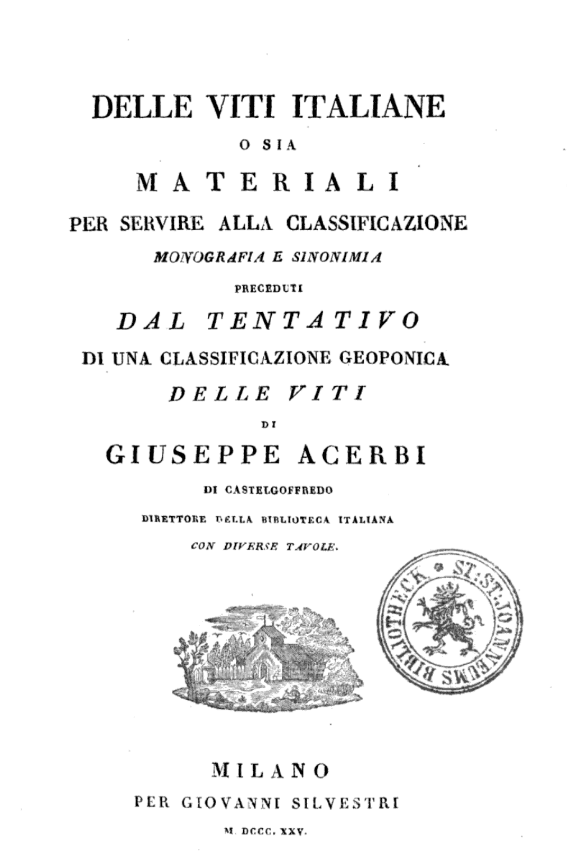

- Calò, A, Scienza, A, and Costacurta, A, 2006, Vitigni d’Italia, 2nd edn, Edagricole Calderini, Bologna
- Chomé Fuster, P M (co-ordinator), 2006, Variedades de vid: registro de variedades comerciales, Ministerio de Agricultura, Pesca y Alimentación, Madrid.
- Christensen, L P, Dokoozlian, N K, Walker, M A, Wolpert, J A, 2003, Wine grape varieties in California, publication 3419, University of California, Agriculture and Natural Resources, California
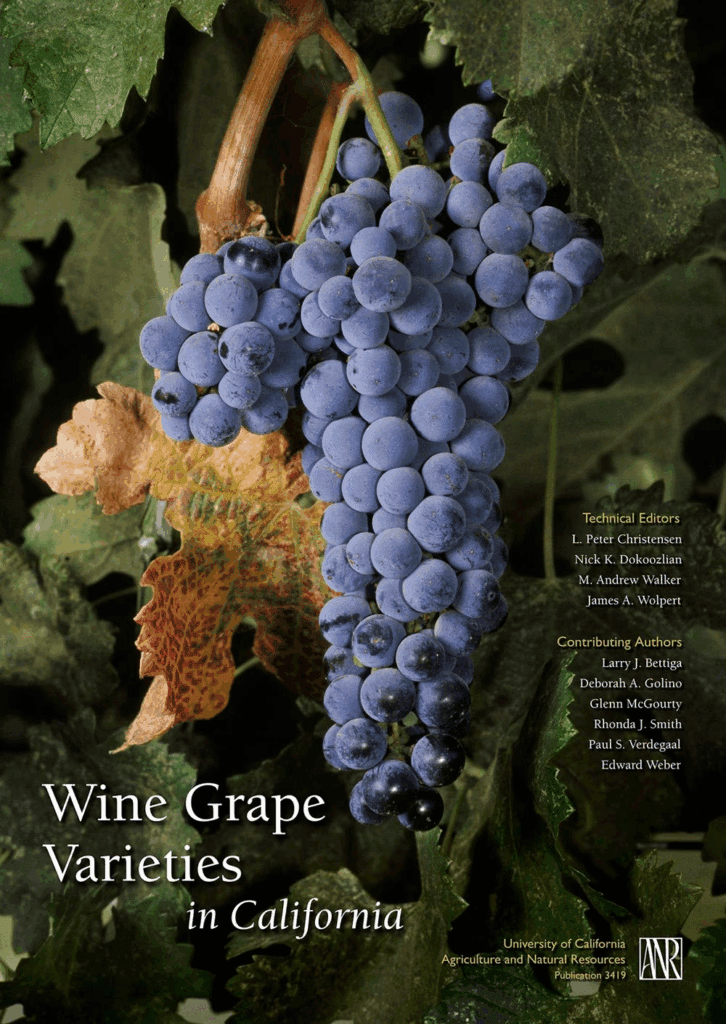
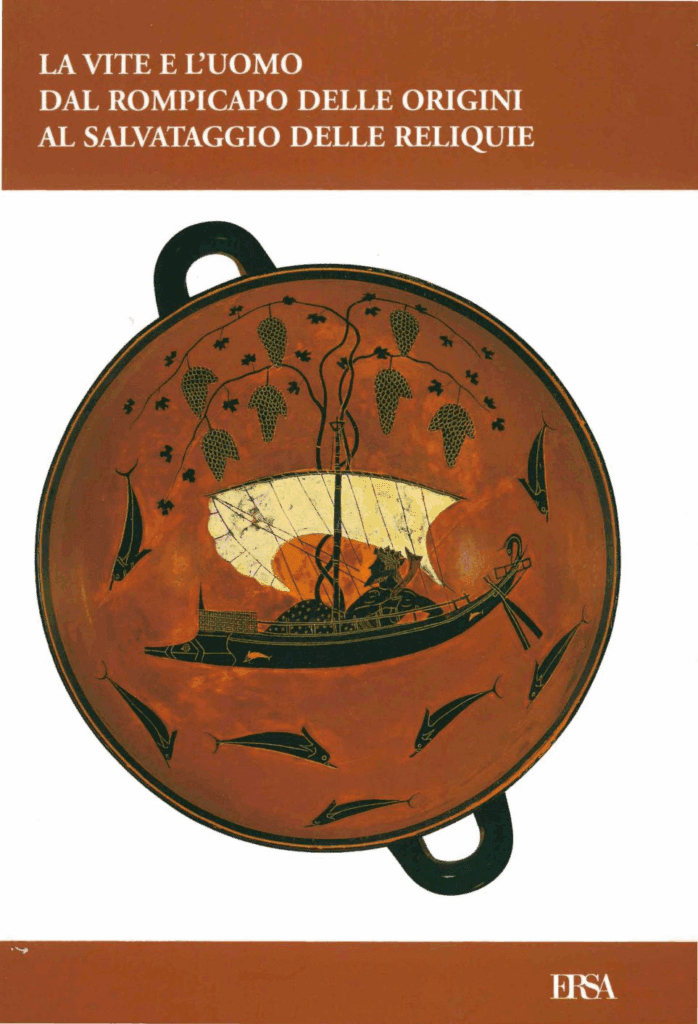
- Di Rovasenda, G, 1877, Saggio di una ampelografia universale, Tipografia Subalpina di Stefano Marino, Torino
- Dupraz, P, and Spring, J-L, 2010, Cépages: principales variétés de vigne cultivées en Suisse, Agroscope/École d’ingénieurs de Changins, Changins
- Galet, P, 1988, Cépages et vignobles de France, vol I, Les vignes américaines, 2nd edn, Charles Déhan, Montpellier
- Galet, P, 1990, Cépages et vignobles de France, vol II, L’ampélographie française, Charles Dehan, Montpellier
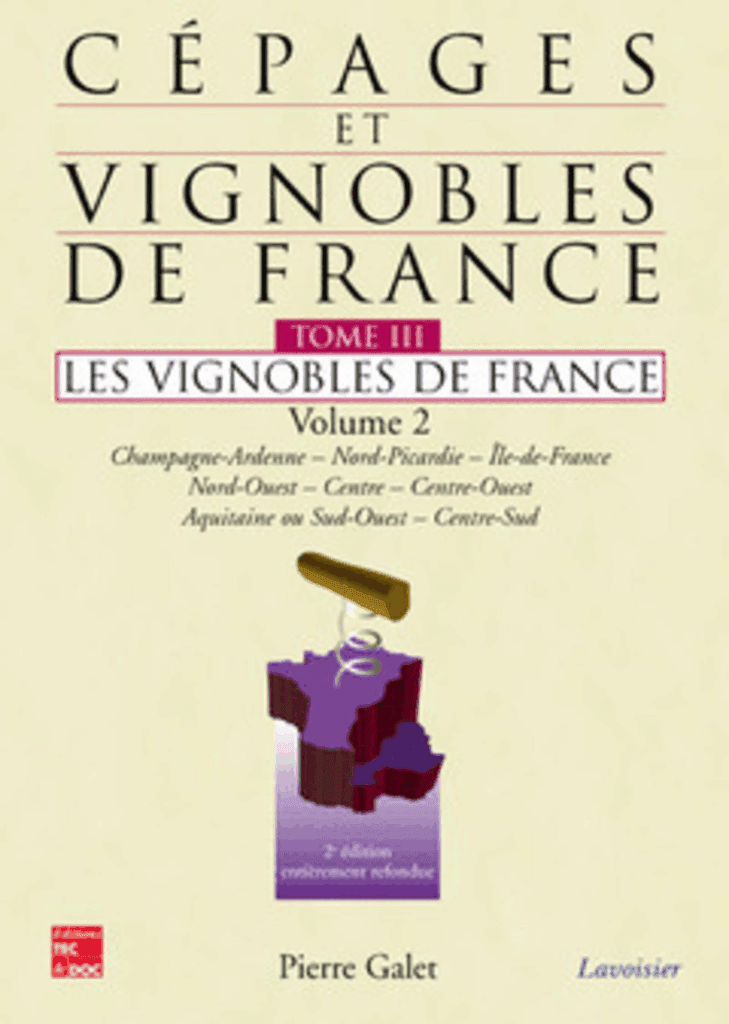
- Galet, P, 2000, Dictionnaire encyclopédique des cépages, Hachette, Paris
- 2015 (2nd edition: Dictionnaire encyclopédique des cépages et de leurs synonymes
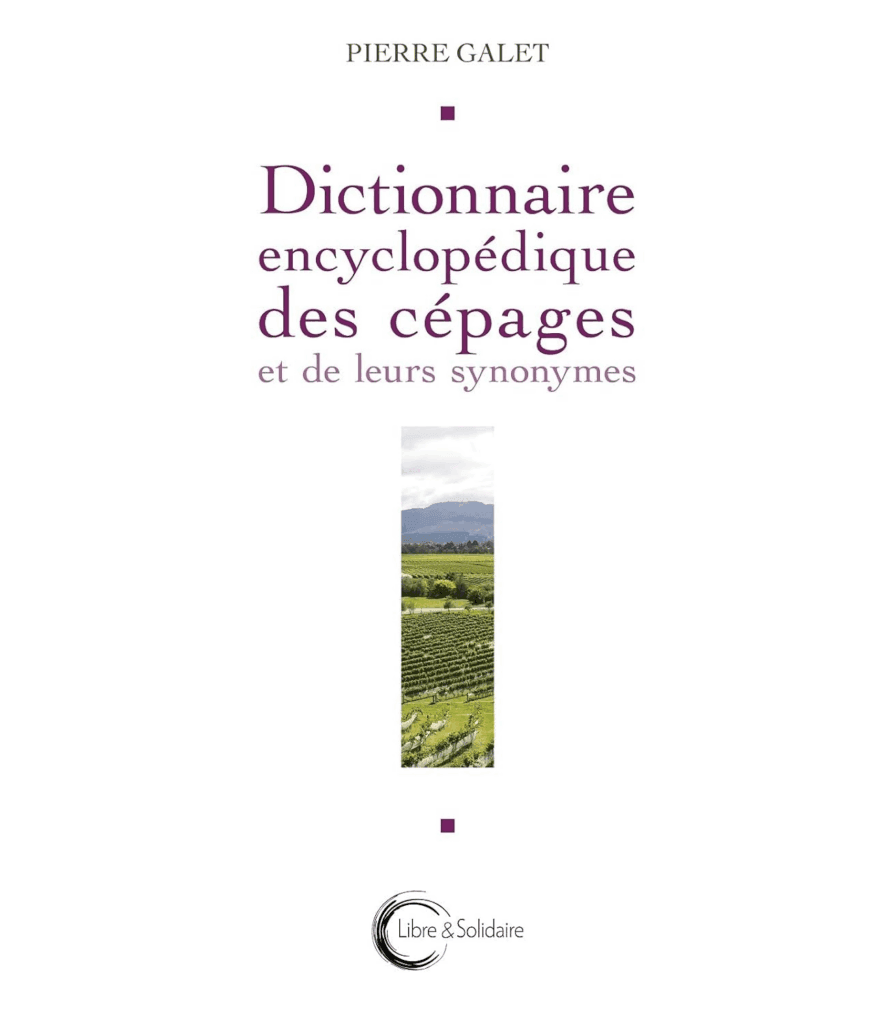
- Giavedoni, F, and Gily, M, 2005, Guida ai vitigni d’Italia. Storia e caratteristiche di 580 varietà autoctone, Slow Food Editore, Bra

- Institut Français de la Vigne et du Vin, 2007, Catalogue des variétés et clones de vigne cultivés en France, 2nd edn, INRA, SupAgro, Viniflhor, Entav-ITV , Montpellier

- Lavignac, G, 2001, Cépages du Sud-Ouest: 2000 ans d’histoire, Rouergue/INRA, Rodez
- Rézeau, P, 1997, Dictionnaire des noms de cépages de France, CNRS, Paris

- Schneider, A, and Mannini, F, 2006, ‘Vitigni del Piemonte – varietà ecloni’, Quaderni della Regione Piemonte – Agricoltura, Supplement 50 (332 pp)
- Schneider, A, Raimondi, S, Grando, M S, Zappia, R, De Santis, D, Torello Marinoni, D, and Librandi, N, 2008, ‘Studi per il riordino del germoplasma viticolo della Calabria’, in Fregoni, C, and Nigra, O (eds), Il Gaglioppo e i suoi fratelli I vitigni autoctoni calabresi, Librandi Spa, Cirò Marina, pp 114–25
- Smiley, L A, 2008, ‘A review of cold climate grape cultivars’, MS project, Iowa State University (available online)
- Viala, P, and Vermorel, V , 1901–10, Ampélographie, 7 vols, Masson, Paris
- Žunec, N (ed), 2009, Vinogradarski and vinski atlas Hrvatske / Viticulture and wine atlas of Croatia, Business Media Croatia, Zagreb
See Also
More recent publications

- Grands cépages d’origine Française, José Vouillamoz (2025)

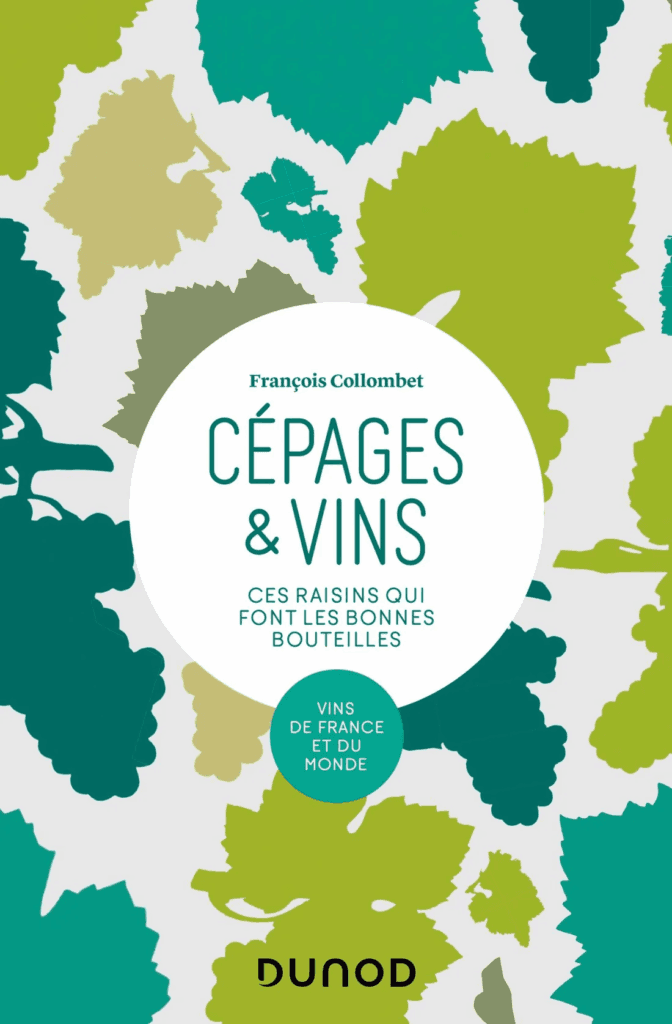
- Cépages Suisses – Histoires et Origine, José Vouillamoz (2017)

- Grapes & Wines: A Comprehensive Guide to Varieties and Flavours by Oz Clarke and Margaret Rand (2015)

- Native Wine Grapes of Italy, Ian D’Agata (2014)

- Vines, Grapes & Wines, Jancis Robinson (1986)
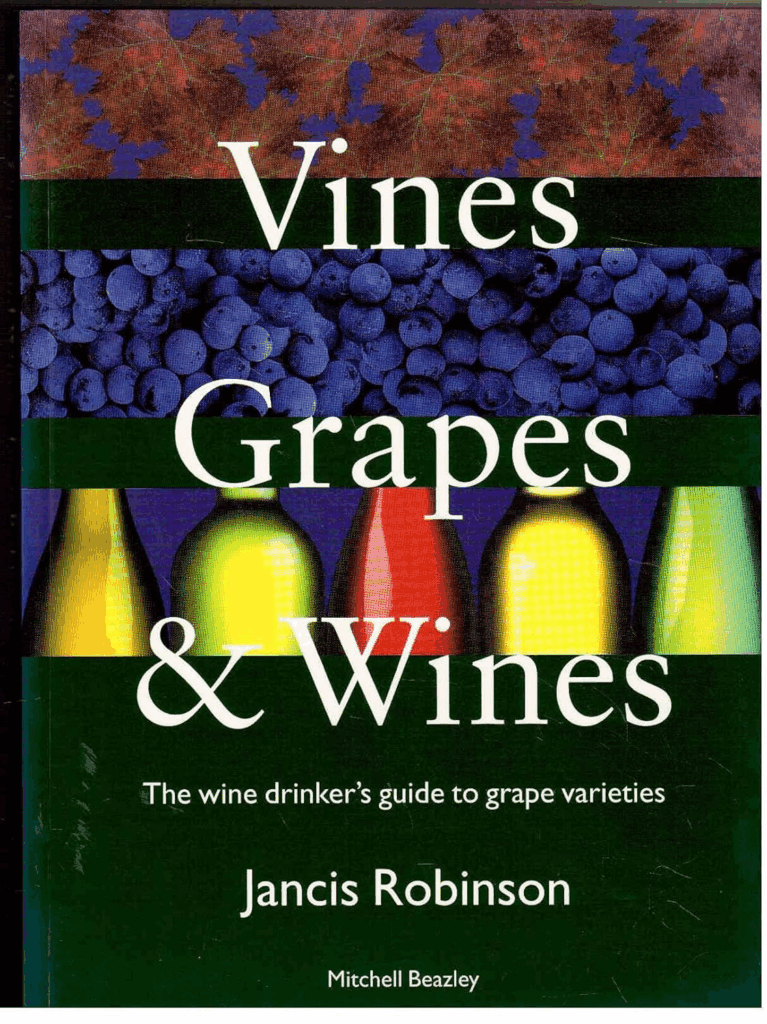
Online Resources
- Vitis International Variety Catalogue VIVC – Julius Kühn Institut
